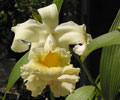|
|
|
|
|
| |
Flasks of
Sobralia xantholeuca 'No. 4' × self |
|
| |
|
|
| |
| Number: |
TN5092 |
| Name: |
Sobralia xantholeuca 'No. 4' × self
|
| Type: |
self (What's that?) |
|
Seed Donor: |
Virginia Magnus
|
|
Click to Enlarge

Pod Parent Flower |
|
|
|
| |
Culture Notes from Donor: Parent plant: Plant is growing outside in Southern California (average temperatures 55-75°F).
Comments: Parent plant: Blooms last 4 days but are produced successively from the same canes over a period of a few months. This individual originally came from the Santa Barbara Orchid Estate, where it was labeled "Sobralia xantholeuca No. 4." Large plant.
For additional origin/habitat information supplied courtesy of
Charles and Margaret Baker, see further below, near the bottom of this page.
|
Temperatures we attempt to use in the lab & greenhouse:
| For Species: |
|
Spring, Summer, Autumn: days average 78°F, nights 60°F; best fit is Cool-Intermediate 75-58°F
(Source:
Baker's Web OSC) |
| For Species: |
|
Winter: days average 74°F, nights 53°F; best fit is Cool 70-52°F
(Source:
Baker's Web OSC) |
|
About the name...
| Etymology of |
Sobralia |
|
Named for Dr. Francisco Sobral, Spanish botanist of the latter part of the 18th century.
(Source:
Pridgeon 1992) |
| Etymology of |
xantholeuca |
|
From latinized Greek "xantholeucus" yellow-white.
(Source:
Mayr & Schmucker 1998) |
| Pronunciation of |
Sobralia |
|
so-BRAL-ee-ah
(Source:
Pridgeon 1992) |
| Pronunciation of |
xantholeuca |
|
zan-thoe- LOO-ka
(Source:
Hawkes 1978) |
|
If you would like to direct someone to this web page, please copy and paste this URL into your email:
http://troymeyers.com/d?015092
| Flask Information |
| Availability: |
We have sold all of the flasks for this item. |
| You should: |
Consider getting individual plants or compots instead of a flask.
You can place a "Notify Flask Recipients" Request, and either we or a flask recipient may contact you when plants are available.
You may also place a "Notify Retries" Request, and if an identical pollination (the same parents) is done again, we'll let you know.
You may reserve a flask, but it's very unlikely you'll get one ...this could only happen if we found a flask that we didn't know we had. |
| Yield Estimate: |
172 plants (based on flask surveys done 05/10/2006 through 09/11/2008)
|
| Plantlet Sizes: |
From many flasks 15 - 110 mm plants (based on flask surveys done 06/28/2006 through 01/20/2009)
From one most recently surveyed flask 15 - 100 mm (01/20/2009)
|
|
You might also want to:
|
View the seed assay for this item.
View items of the same species.
View items of the same genus.
|
| Ordering Information |
| You are not currently logged in. |
|
You must be a registered user and be logged in to reserve a flask or place a notification request. Please log in:
|
|
|
|
|
|
| |
The origin/habitat information below is supplied courtesy of Charles and Margaret Baker
The following information is based on the name of the plant provided by the donor, and assumes that the name is correct. If the plant has been misidentified, then the following information may not be correct.
This text is copyrighted by the Bakers and may not be reproduced without permission.
ORIGIN/HABITAT: Mexico, Guatemala, and El Salvador. This was originally
described from a plant of unstated origin. Plants have since been found in
southern Mexico where they are rather common in the pine-oak forests of
the Central Plateau in the southernmost state of Chiapas at 2600-5250 ft.
(800-1600 m). It was also reported to be found but scarce in mountain rain
forest. Plants have also been found in Guatemala where they were described
as uncommon and growing as epiphytes on trees and on rocks at up to 5100
ft. (1550 m) near San Cristobal and Cobán in department of Alta Verapaz as
well as in dense wet woods between Yulhuitz and Maxbal in Huehuetenango.
Plants have been reported in El Salvador where they were growing as
terrestrials on Cerre Montecristo at 5600 ft. (1700 m)
More about this information and the Bakers...
|
|
|
| |
|
|
|